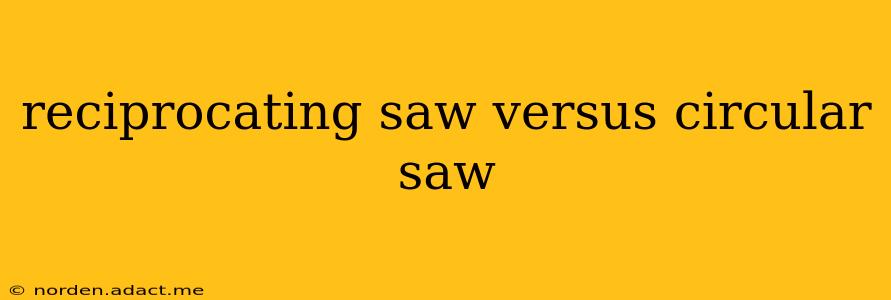Reciprocating Saw vs. Circular Saw: Which Saw Reigns Supreme?
Choosing between a reciprocating saw and a circular saw can feel overwhelming, especially for DIY enthusiasts and professionals alike. Both are power tools essential for various cutting tasks, but their design and functionality differ significantly, making them ideal for distinct applications. This comprehensive guide will dissect the strengths and weaknesses of each saw, helping you determine which tool best suits your needs.
What is a Reciprocating Saw?
A reciprocating saw, often called a "sawzall," uses a reciprocating (back-and-forth) blade motion to cut through various materials. Its versatility lies in its ability to tackle curved cuts, demolition work, and cutting in tight spaces where a circular saw would struggle.
What is a Circular Saw?
A circular saw uses a rotating circular blade to cut straight lines through materials. It's generally faster and more efficient for straight cuts in wood, plywood, and other sheet materials. Its design makes it less suitable for intricate cuts or working in confined areas.
H2: Key Differences: Reciprocating Saw vs. Circular Saw
Here's a breakdown of the core distinctions between these two power tools:
| Feature | Reciprocating Saw | Circular Saw |
|---|---|---|
| Blade Motion | Reciprocating (back and forth) | Rotating |
| Cut Type | Straight, curved, plunge cuts | Primarily straight cuts |
| Material | Wood, metal, plastic, drywall, PVC pipe | Wood, plywood, sheet metal, plastic |
| Accuracy | Lower accuracy for straight cuts, high for curves | Higher accuracy for straight cuts |
| Portability | Highly portable, often cordless options available | Can be portable, but typically corded and heavier |
| Speed | Slower than circular saw for straight cuts | Faster for straight cuts |
| Versatility | Highly versatile for various materials and cuts | Less versatile, primarily for straight cuts |
H2: What type of cuts can a reciprocating saw make?
Reciprocating saws excel at making various cuts:
- Straight Cuts: While not as precise as a circular saw, they can manage straight cuts, particularly in thicker materials or where a circular saw can't reach.
- Curved Cuts: This is where the reciprocating saw truly shines. Its blade's back-and-forth motion allows for easy negotiation of curves and intricate shapes.
- Demolition Cuts: These saws are powerful enough for demolition work, cutting through framing lumber, pipes, and other tough materials.
- Plunge Cuts: Starting a cut in the middle of a workpiece is easy with a reciprocating saw, ideal for removing sections from larger pieces.
H2: What type of cuts can a circular saw make?
Circular saws are best suited for:
- Straight Cuts: Their rotating blades provide precise, fast straight cuts, making them ideal for ripping lumber or cutting sheet materials to size.
- Bevel Cuts: Many circular saws offer bevel adjustments, allowing angled cuts for miter joints and other applications.
- Cross Cuts: Quickly cutting across the width of a board is efficiently accomplished with a circular saw.
H2: Which saw is better for woodworking?
For most woodworking projects, a circular saw is generally preferred for straight cuts due to its speed and accuracy. However, a reciprocating saw is invaluable for intricate cuts, curves, and demolition tasks within a larger woodworking project. Both tools often work in tandem on complex builds.
H2: Which saw is better for metal cutting?
The reciprocating saw is the clear winner for metal cutting. While circular saws can cut some thin metals, reciprocating saws handle thicker materials and various metal types with ease, thanks to the appropriate blade selection.
H2: Which saw is easier to use?
This depends on the user's experience and the task at hand. For straight cuts, a circular saw is arguably easier to use once proper technique is learned. Reciprocating saws have a simpler control mechanism, making them easier to master for beginners on less precise cuts.
H2: Which saw is safer?
Both saws present safety hazards. Proper safety precautions, including eye protection, hearing protection, and appropriate clothing, are essential for both. A circular saw presents a higher risk of kickback, while a reciprocating saw's blade can bind, creating a potentially dangerous situation. Always prioritize safety training and follow manufacturer instructions.
Conclusion:
The "best" saw depends entirely on your specific needs. Consider the types of cuts you'll frequently perform, the materials you'll be working with, and your budget. For many workshops, owning both a reciprocating saw and a circular saw offers unmatched versatility and efficiency for a broad range of projects.
